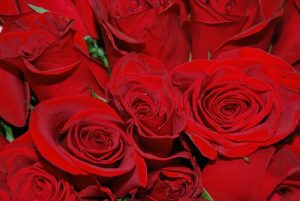Mantay, Motherhood in Cuzco

Mothers will be celebrated throughout Cuzco today as Peru celebrates Mother’s Day. In honor of Cuzco’s women, and not just mothers, we wanted to give some distinctive details of life in the Imperial city of Cuzco.
Perhaps the most important figure of Motherhood here is not the greeting card mother or the endless balloons and flower bouquets enshrined with words of love, sacrifice, patience, and dedication to their children. Instead it is the Pachamama a woman with very deep roots into the Andean past.
She is the Lady of Space and Time, although located in the earth and its hills and mountains. May is a time when she begins to rest from the expense of energy during the growing season. These days the people of Cuzco begin to make ovens of dirt clods in the city’s patios as well as in nearby fields. They form them carefully into a carefully balanced dome shape with a rounded opening. This requires skill and patience as they work the puzzle to put the various clods together so they support each other and make a closed vault with no other support than the clods.
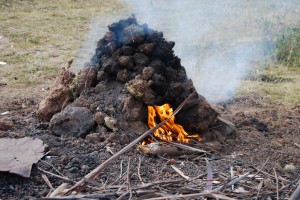
They fill the vault with sticks and light a fire, burning it to an ash and intensely heating the clods. When the fire fades they break the vault and start laying potatoes and other tubers, as well as broad beans, in the dirt before covering it all in a mound of dirt. Then they wait, while talking, laughing, and drinking. After the right amount of time, maybe twenty minutes, they carefully rake back the dirt and “harvest” the now cooked tubers and fava beans. They eat and eat, peeling back the skins and adding an uchukuta, a hot sauce, onto the food.
Cooking, transforming food, is here symbolized as part of the great image of the Pachamama, who carries food within her, tubers and other roots, and who sprouts seeds, feeding them to grow into food.

The image conjoins with the idea of a woman and her womb, growing seed into a child, then clothing it–like placing uchu, hot sauce, on the potatoes–and caring for it as it grows.
When we were discussing this among the Cuzco Eats team here in a cafe here in Cuzco, Brayan carried the idea further. “Just as the Pachamama has her skirt, the sides of the hills on which we all played as children, so too our mothers have skirts on which we sat and nursed or later climbed when we were children.”
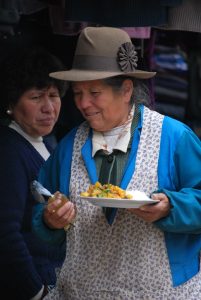
Nourishing and watching over are certainly key characteristics of the Pachamama, as well as the mountain Apus, Lords, who arise from her. It is common in Quechua to compare people to domestic animals and the earth or mountains to herders who look out for them and care for them.
But the relationship is never one way. Just as it requires villagers and city dwellers to make offerings to the earth in August as a kind of feeding or payment, it also requires children and domestic animals to do things for their mothers, whether these are household tasks, outright work, or even taking flowers and balloons, or a cake, to their mother to greet her today.
That word “greet” is important. People use the Latinate word saludar, whose root is salus, related to the Latin greeting salve. As a verb it leads to a another word, salvation, as well as to the idea of wishing good health and fortune. The greeting of a mother, whether today or any day, is an auspicious act focused on and made serious in Cuzco, not because of Roman origins, but because of the way it combines with Quechua understandings of human interaction.
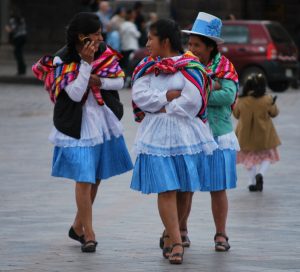
As a result let us look just a bit at some of the language of greetings. In Cuzco we find the words mamá or papá, sometimes in the diminutive, used to address people in all kinds of circumstances. In any case, its point is to express warmth as well a to build a kin-like relationship for a moment, whose essence lies in the caring for each other and doing things for each other typical of Andean reciprocity, Ayni.
Walter pointed out that when the people of Cuzco are walking the streets and see a woman dressed in a pollera, a broad traditional skirt, and perhaps wearing a hat they will call her mantay, a word in local Quechua which is said to mean “my mother”. They also call women from rural areas, often in indigenous dress, as well s market women, mamachas, which is the Quechua word for Lady as well as mother, like in Pachamama, with the Quechua suffix -cha, which expresses warmth and endearment.
While we were discussing this, Walter and Arnold argued for children it was like every older woman was their mother and would take care of them if they needed. In return, they owed them respect and warmth, acknowledging their position as senior women and mothers over the children, so they greeted them, not with a ma’am, or Spanish señora–that is reserved for upper class women, instead they called the one version or another of the word mother.
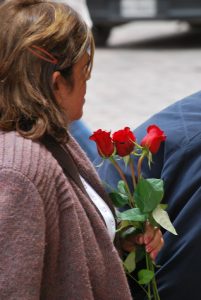
The idea of motherhood, like in Polynesia with its famous Hawaiian kinship terminological system, is spread out from the nuclear family mother, the ideal of Mother’s Day, to encompass all women of a generation above you of your rough class. From there it is not hard to broaden the idea to include the Earth herself, in her encompassing of Space and Time.
We at Cuzco Eats wish all women in Cuzco a happy Mother’s Day and celebrate with them this very rich and complex culture of their’s which makes sense of their daily lives in ways that are not those of the international industries who depend on sales for this day.
